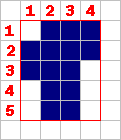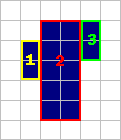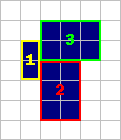Area
|
Student: Is there a way to calculate the area of random shapes without having to count every block? Mentor: Yes there several ways. Let's look at an example of the box method first. The first step is to "box" the object in. Then count the length and width of "the box".

Student: For this example the length is 4 and the width is 5. Mentor: The area of a rectangle is length times width. So, who can tell me the area of the "box"?
Student: The area of the box is four times five, which is twenty. But what does that have to do with the area of the shape inside? Mentor: Good question. How many squares are there in "the box" that are not a part of the object? Student: There are six squares in "the box" that are not a part of the object. Mentor: The area of the object is the area of "the box" minus the squares that are not part of the object. Student: The area of this object is twenty minus six, which equals fourteen. This method does reduce the amount of counting a little. But, what about the other method? Mentor: The other method is called the break down method. In this method, you break down the shape in to rectangles. Here is an example:

Student: Does it matter how you break it down into rectangles? What if I broke it down like this:

Mentor: It does not matter how you break it down. The way you broke it down is fine. In fact I will use your picture as the example. Who can tell me the area of section one? Student: The length is one and the width is two so the area is two. Mentor: Now, who can tell me the area of section two? Student: The length is two and the width is three so the area is six. Mentor: Finally, can any one tell me the area of section three? Student: The length is three and the width is two so the area is six. Mentor: The area of the shape is the sum of it's sections. Two plus six plus six equals fourteen. Now lets practice on some larger shapes to see how much our new methods reduce the amount of counting. |
